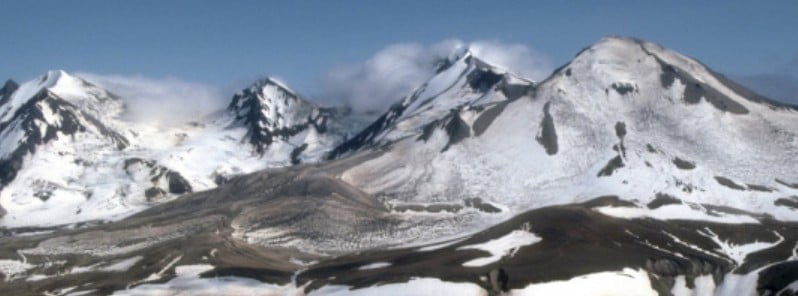Earthquake swarm under Trident stratovolcano, Alaska

A seismic swarm started under Trident stratovolcano, Alaska on August 24, 2022, likely driven by the movement of magma or magmatic fluids. The swarm is still in progress but now at a decreased rate. The last eruption of this volcano took place in 1974 (VEI 3).
- Trident is one of the Katmai group of volcanoes located within Katmai National Park and Preserve on the Alaska Peninsula. It consists of a complex of four cones and numerous lava domes, all andesite and dacite in composition.
- An eruption beginning in 1953 constructed the newest cone, Southwest Trident, and four lava flows on the flank of the older complex. This eruption continued through 1974 and produced ash – an initial plume rose to 9.1 km (30 000 feet) above sea level, bombs, and lava at various times.
Earthquake depths at the beginning of the swarm were mostly deep, around 25 km (16 miles) below sea level, and became progressively shallower to around 5 km (3 miles) by August 28, the Alaska Volcano Observatory (AVO) reports.1
Since August 28, most earthquakes have been at depths of 0 to 7 km (0 to 4.3 miles) below sea level.
Earthquake magnitudes have ranged from 0.7 to 1.9.
At the peak of the swarm, dozens of earthquakes were occurring daily beneath the volcano, and over the past week earthquake rates have decreased to just a few per day.
A few episodes of weak seismic tremor and low frequency earthquakes have also occurred. No other signs of unrest have been detected in available monitoring data.
The increase in seismic activity is likely caused by the movement of magma or magmatic fluids, AVO said.
Increases in seismic activity have been detected previously at Trident and other similar volcanoes, with no subsequent eruptions.
“We expect additional shallow seismicity and other signs of unrest, such as gas emissions, elevated surface temperatures, and surface deformation to precede any future eruption, if one were to occur.”
Should activity increase, AVO will issue further notices and possibly increase the Aviation Color Code and Volcano Alert Level.
AVO monitors Trident with a local network of seismometers, a webcam, remote sensing data, and regional infrasound and lightning networks.
Geological summary
The Trident stratovolcano cluster was named for the three prominent peaks that were the most visible features at the summit prior to 1953.
The andesitic-dacitic group consists of four overlapping stratovolcanoes and numerous flank lava domes, including Falling Mountain and Mt. Cerberus on the far west flank.
The summit complex is located 3 – 5 km (1.8 – 3.1 miles) SE of Novarupta volcano, and merges along a ridge to the NE with Katmai.
The three oldest Trident volcanoes are glaciated and Pleistocene in age, while the youngest, Southwest Trident, was formed during historical time.
Eruptions migrated through time from the NE to the SW. In 1953 a new lava dome began growing on the SW flank of Trident I volcano.
A series of thick andesitic lava flows were erupted between 1953 and 1968, forming a cone with 400 – 800 m (1 312 – 2 624 feet) of local relief.
Periodic explosions took place until 1974, and the current summit contains a 350 m (1 148 feet) wide crater.
Some of the distal lava flows from West Trident stratovolcano collapsed into the Novarupta vent during its 1912 eruption.2
References:
1 Trident volcano – Alaska Volcano Observatory information statement released at 17:16 UTC on September 14, 2022
2 Trident volcano – Geological summary – GVP
Featured image: The multiple peaks of Trident Volcano as viewed from the top of Baked Mountain in the Valley of Ten Thousand Smokes, Alaska. Trident Volcano is composed of a cluster of andesite and dacite cones and is the only Katmai group volcano other than Katmai and Novarupta to have had historical activity. The Novarupta lava dome is visible at bottom, center. Photograph by R. McGimsey, U.S. Geological Survey, July 12, 1990.

Commenting rules and guidelines
We value the thoughts and opinions of our readers and welcome healthy discussions on our website. In order to maintain a respectful and positive community, we ask that all commenters follow these rules.